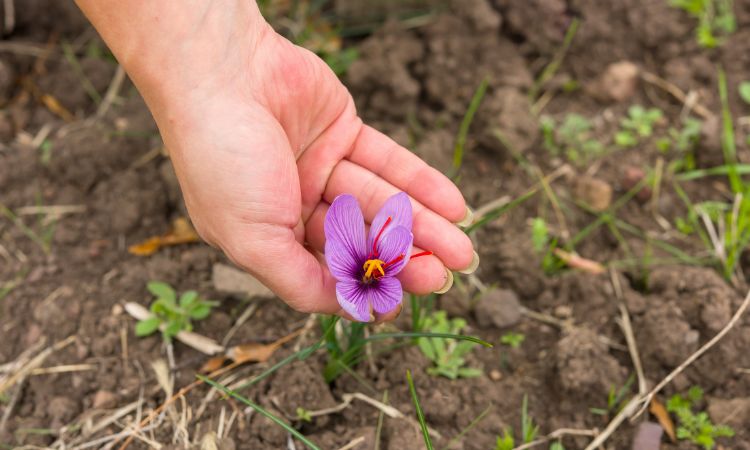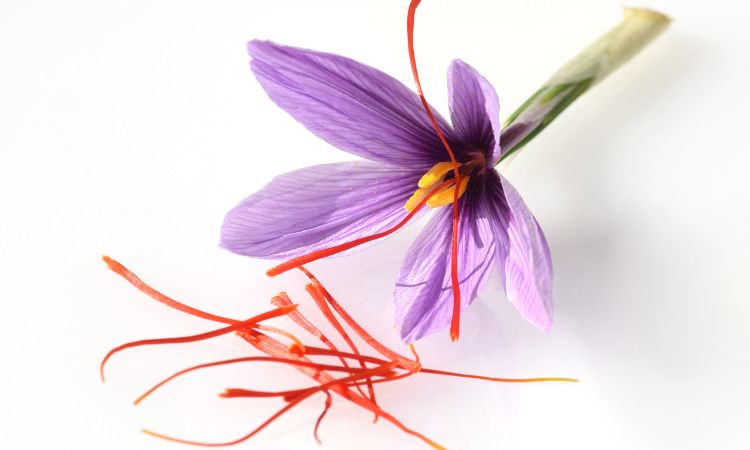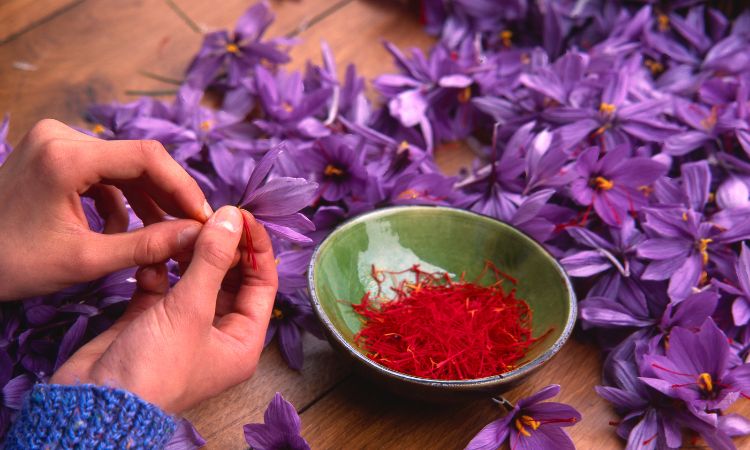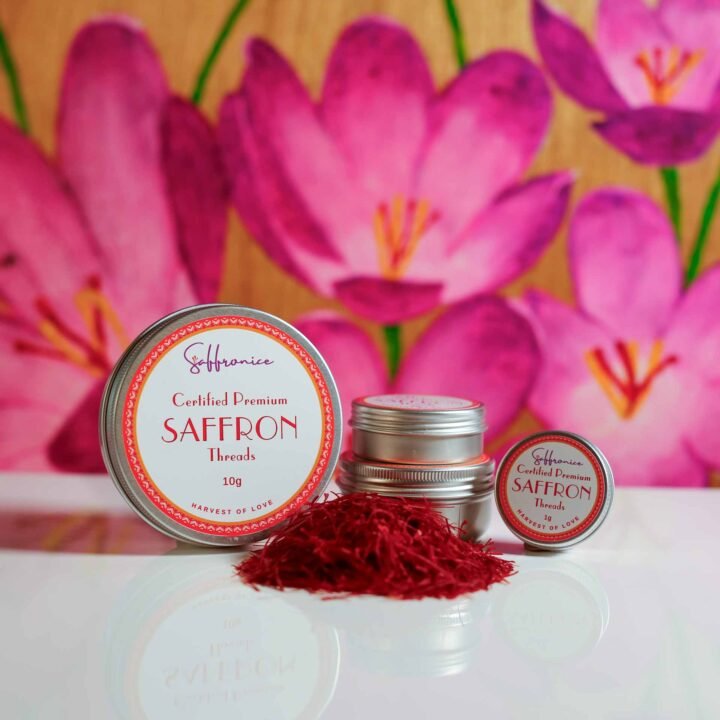Ever wondered how to grow the world’s most precious spice without synthetic chemicals? Saffron—the vibrant red-orange stigmas of the Crocus sativus flower—represents both a culinary treasure and an opportunity for sustainable agriculture. Known for its distinctive flavor, intense aroma, and remarkable health benefits, saffron commands prices up to $6,000 per kilogram, making organic saffron cultivation an attractive venture for eco-conscious gardeners and small-scale producers.
Organic saffron farming offers unique advantages over conventional methods. The Crocus sativus—a fall-blooming perennial—thrives in Mediterranean climates and adapts successfully to USDA Zones 6 and above with proper care. By embracing organic practices, you can produce high-quality, chemical-free saffron while improving soil health, supporting beneficial organisms, and meeting growing consumer demand for sustainably produced spices.
📌 Quick Answer: Organic saffron farming eliminates synthetic pesticides and fertilizers, instead using compost, natural pest control (beneficial insects, neem oil), companion planting, and proper cultural practices. Plant corms 2-3 inches deep in well-drained soil (pH 6-8) in early fall, harvest flowers in October-November, carefully extract stigmas by hand, dry them properly, and store in airtight containers. Organic certification requires following approved practices and documentation.
Key Takeaways
- Saffron ranks as the world’s most expensive spice ($3,000-$6,000/kg)
- Producing one pound requires approximately 75,000 flowers (14,000-15,000 per ounce)
- Organic methods build soil health while producing premium-quality saffron
- Plant corms 2-3 inches deep, 3 inches apart in well-drained, sunny locations
- Saffron tolerates frost to 14°F (-10°C) and thrives in hot, dry summers
- Natural pest management protects crops without synthetic chemicals
- Proper harvesting and processing techniques maximize quality and market value

Understanding Saffron: The World’s Most Precious Spice
Historical Significance and Market Value
Saffron’s rich history spans thousands of years across multiple civilizations. Ancient cultures treasured this spice for culinary applications, medicinal uses, textile dyeing, and even religious ceremonies. In the 7th century, saffron’s value exceeded gold, reflecting its rarity and labor-intensive production process.
Today’s global saffron market remains robust, with Iran dominating production through over 107,000 acres dedicated to cultivation in 2018. Afghanistan and Spain follow as significant producers, though Iran supplies approximately 90% of the world’s saffron. This concentration creates opportunities for organic producers in other regions to serve niche markets demanding locally grown, certified organic saffron.
Understanding saffron farming economics helps contextualize organic production. The high market value stems from extreme labor requirements—approximately 70,000 blooms yield just one pound of dried saffron. A single kilogram requires roughly 220,000 flowers, with each flower providing only three valuable stigmas. This scarcity, combined with increasing organic market demand, positions organic saffron farming as an attractive agricultural opportunity.
Chef’s Professional Tip: Working with saffron in professional kitchens has taught me that organic saffron often exhibits more complex flavor profiles than conventionally grown alternatives. The absence of synthetic inputs seems to enhance the development of secondary metabolites responsible for saffron’s characteristic flavor nuances. When sourcing for high-end restaurants, I specifically seek organic certification as a quality indicator.
Botanical Characteristics of Crocus Sativus
The saffron crocus (Crocus sativus) belongs to the Iridaceae family, displaying distinctive characteristics that set it apart from other crocus species. The plant produces narrow, grass-like leaves marked by a white central stripe, emerging alongside or shortly after the delicate lavender flowers.
Key Botanical Features:
- Sterile Hybrid: Cannot reproduce through seeds; propagation occurs exclusively through corm division
- Fall Flowering: Blooms October-November (Northern Hemisphere), opposite most flowering plants
- Stigma Anatomy: Each flower produces three vivid crimson stigmas connected by a yellow style
- Corm Structure: Underground storage organs multiply annually, producing daughter corms
- Perennial Nature: Corms remain productive 3-5 years before requiring division and redistribution
Food Scientist’s Note: Crocus sativus’ genetic sterility creates both challenges and advantages. While preventing genetic variation and seed production, this sterility ensures consistent biochemical profiles across harvests. The three stigmas contain concentrated amounts of crocin (color), picrocrocin (flavor), and safranal (aroma)—the compounds determining saffron quality standards.
Global Organic Saffron Production
Organic saffron production remains relatively limited compared to conventional cultivation, creating market opportunities for certified organic producers. While precise global organic production statistics are unavailable, the organic spice market continues expanding rapidly, with consumers increasingly willing to pay premiums for certified organic products.
Key Market Considerations:
- Family-scale operations (150-200 corms) can produce sufficient saffron for personal use and small-scale sales
- Organic certification adds value, justifying 20-30% price premiums over conventional saffron
- Specialty markets, high-end restaurants, and health-conscious consumers actively seek organic saffron
- Direct marketing through farmers’ markets, online sales, and local food networks maximizes profitability
Essential Growing Requirements for Organic Saffron Farming
Successful organic saffron cultivation begins with understanding and meeting the crop’s specific environmental needs while adhering to organic production standards.
Soil and Sunlight Needs
Saffron crocus thrives in well-drained soil with specific characteristics supporting healthy corm development and preventing common diseases.
Optimal Soil Conditions:
- pH Range: 6.0-8.0 (optimal: 7.0-7.5)
- Texture: Sandy loam or loamy soil providing excellent drainage
- Organic Matter: 2-4% supporting nutrient availability and soil structure
- Depth: Minimum 8-10 inches of workable soil
- Drainage: Water must not pool or accumulate around corms
Light Requirements:
Saffron requires full sun to partial shade, needing a minimum of -8 hours of direct sunlight daily for optimal flower production. In extremely hot climates (above 35°C regularly), afternoon shade protects flowers during the bloom period. Understanding saffron farming climate requirements helps select appropriate sites and implement necessary adaptations.
Planting Density and Bulb Selection
Proper corm selection and planting density significantly influence first-year productivity and long-term success.
Corm Size Guidelines:
- Size 9/10 or Larger: Produces reliable first-year blooms (recommended for new plantings)
- Size 8/9: Blooms 40-80% in first year; better for established operations expanding gradually
- Smaller Corms: May not bloom first year; suitable only for long-term establishment
Planting Density:
Plant approximately 50 bulbs per square meter (about 5 bulbs per square foot) for optimal spacing. This density allows adequate room for corm multiplication while maximizing productivity per area. For family use, 150-200 corms provide sufficient saffron for annual cooking needs plus some surplus for gifting or sales.
Organic Certification Requirements
Achieving organic certification requires following approved practices and maintaining detailed records. While specific requirements vary by certifying agency, common standards include:
Organic Standards for Saffron:
- Soil Preparation: Three-year transition period if previously treated with prohibited substances
- Fertility Management: Only approved organic fertilizers (compost, aged manure, approved rock minerals)
- Pest Management: Natural controls only—no synthetic pesticides
- Weed Control: Mechanical, manual, or flame weeding; approved organic herbicides only
- Record Keeping: Detailed documentation of all inputs, practices, and harvest data
- Inspection: Annual on-site inspection by certifying agency
- Buffer Zones: Physical separation from conventionally managed areas, preventing contamination
Certifying bodies like USDA Organic (United States), Skal Biocontrol (Europe), and equivalent national agencies provide specific guidelines for organic saffron production. For detailed information about implementing sustainable saffron farming practices, consult your regional certification authority.
Soil Preparation and Site Selection
Thorough soil preparation and strategic site selection prevent common saffron growing challenges and establish optimal growing conditions.
Comprehensive Soil Preparation
Begin preparation 2-3 months before planting, allowing soil to settle and stabilize:
Step 1: Site Assessment and Testing
- Conduct the soil test, determining pH, nutrient levels, and organic matter content
- Assess drainage by digging test holes, filling with water, and monitoring drainage time
- Evaluate sun exposure throughout the day
- Identify potential pest issues (rodents, other animals)
Step 2: Soil Amendment
- Deep cultivation to 8-10 inches, breaking compacted layers
- Incorporate well-aged compost (2-4 inches depth), improving structure and fertility
- Add coarse sand to heavy clay soils (20-30% bvolumeum,e), enhancing drainage
- Mix in organic fertilizers: bone meal (phosphorus), greensand (potassium), kelp meal (trace minerals)
- Adjust pH if needed using approved organic amendments
Step 3: Bed Preparation
- Create raised beds 4-6 inches high, ensuring superior drainage
- Form beds 3-4 feet wide, allowing easy access from the sides
- Install rodent barriers (1/4-inch hardware cloth) if necessary
- Allow soil to settle 4-6 weeks before planting
Optimal pH and Drainage Management
Maintaining proper pH and ensuring excellent drainage represent the two most critical factors for saffron success.
pH Management:
Test soil pH annually and adjust as needed. Saffron tolerates pH 6.0-8.0 but performs optimally at 7.0-7.5. Raise pH with agricultural lime, lower with elemental sulfur or acidifying organic matter (pine needles, peat moss).
Drainage Solutions:
Poor drainage causes corm rot and crop failure. Test drainage by filling holes with water—it should drain within 24 hours. Improve drainage through raised beds, sand incorporation, or selecting naturally well-drained sites. In problematic areas, consider container cultivation for complete drainage control.
Climate Considerations for Site Selection
Choose sites providing appropriate microclimate conditions:
Temperature: Saffron tolerates -15°C (-5°F) when dormant, but prefers moderate conditions during active growth
Dormancy Period: Needs hot, dry summer dormancy (25-35°C) with minimal irrigation
Growing Season: Requires cool autumn for flowering (15-20°C) and cold winter for vegetative growth
Protection: Select sites avoiding frost pockets duthe ring flowering period
Air Circulation: Good airflow reduces disease pressure, especially in humid climates
Planting Techniques and Timing
Proper planting techniques and timing establish a productive saffron stand, generating returns for multiple years.
Optimal Planting Windows
Northern Hemisphere: Early fall planting, mid-September through late October
Southern Hemisphere: March-April (adjust for local conditions)
Timing Considerations:
- Plant 6-8 weeks before typical autumn flowering
- Soil temperature should be 20-25°C at planting depth
- Avoid extreme heat or drought conditions
- Allow time for root establishment before flowering
Detailed Planting Instructions
Corm Orientation and Spacing:
- Spacing: Plant corms 3-4 inches apart in all directions
- Depth: Plant 2-3 inches deep (measured from soil surface to corm top)
- Orientation: Place corms with the flat side (roots emerge here) downward, pointed end upward
- Row Spacing: Space rows 6 inches apart for easy access and management
Planting Process:
- Dig individual holes or trenches to the proper depth
- Place corms with the correct orientation
- Cover with soil, firming gently
- Water thoroughly, settling the soil around the corms
- Apply a 2-3 inch mulch layer (straw, leaves, bark) after planting
- Mark planting locations with stakes or flags
Container Planting:
Container cultivation offers advantages in challenging climates or for small-scale production:
- Use containers minimum of 8-10 inches deep with drainage holes
- Fill with well-draining potting mix amended with compost
- Plant corms 2 inches deep, 3 inches apart
- Place containers in full sun locations
- Move containers to protected areas during harsh winter (zones below 6)
- Easier moisture control in rainy climates
Food Scientist’s Note: Planting depth affects corm temperature during dormancy and winter, influencing biochemical processes. Shallow planting (1-2 inches) exposes corms to greater temperature fluctuations, potentially stressing plants. Deeper planting (3-4 inches) provides insulation but may delay emergence. The recommended 2-3 inches balances these factors optimally.
Organic Pest Management and Protection Methods
Protecting saffron organically requires integrated strategies combining cultural practices, physical barriers, and biological controls. Learn more about managing common issues through understanding saffron irrigation needs, which prevent many problems.
Natural Pest Control Solutions
Common Saffron Pests:
Spider Mites: Tiny arachnids causing stippling and yellowing of leaves
Scale Insects: Armored pests feeding on plant sap
Aphids: Soft-bodied insects clustering on new growth
Thrips: Minute insects causing silvering and distortion
Organic Control Methods:
Beneficial Insects: Encourage or introduce natural predators:
- Ladybugs (eat aphids, scale, mites)
- Lacewings (consume aphids, thrips, mites)
- Predatory mites (control spider mites)
- Parasitic wasps (attack various pests)
Organic Sprays:
- Insecticidal soap: Controls soft-bodied pests (aphids, mites)
- Neem oil: Broad-spectrum organic pesticide disrupting pest life cycles
- Horticultural oil: Smothers pests during the dormant season
- Rubbing alcohol solution (70%): Spot treatment for scale insects
Application Guidelines:
- Apply early morning or evening, avoiding direct sun
- Spray thoroughly, covering all plant surfaces
- Repeat applications every 5-7 days as needed
- Rotate products, preventing pest resistance
Protective Measures Against Rodents
Rodents (voles, mice, gophers) and larger animals (rabbits, deer) find saffron corms attractive food sources.
Physical Barriers:
Underground Protection:
- Line planting beds with 1/4-inch hardware cloth
- Extend barriers 6-8 inches below the ow surface
- Overlap edges preventing entry gaps
Above-Ground Protection:
- Install fencing around plantings (24-36 inches high for rabbits)
- Use individual wire cages for small plantings
- Apply crushed oyster shells or diatomaceous earth around plants (deters some pests)
Deterrents:
- Plant strongly scented herbs (garlic, alliums) as borders
- Use motion-activated sprinklers
- Apply approved organic repellents periodically
Companion Planting Benefits
Strategic companion planting enhances pest control while creating attractive, functional landscapes:
Beneficial Companions:
Lavender: Repels moths, fleas, flies; attracts beneficial insects
Rosemary: Deters cabbage moths, bean beetles, carrot flies
Marigolds: Repel aphids, mosquitoes; some varieties deter nematodes
Garlic/Alliums: Repel aphids, Japanese beetles, spider mites
Nasturtiums: Trap crop for aphids, attracts beneficial predators
Planting Strategy:
- Interplant companions among saffron rows
- Create borders around saffron beds with protective plants
- Maintain adequate spacing, preventing competition
- Choose companions with similar water requirements
Chef’s Professional Tip: Companion planting with culinary herbs creates dual-purpose gardens. The same rosemary and lavender that protect your saffron enhance your kitchen repertoire. I’ve found that gardens integrating herbs, vegetables, and specialty crops like saffron provide superior biodiversity and resilience compared to monocultures.

Water Management and Irrigation Practices
Proper water management prevents common problems while supporting optimal plant health. Understanding saffron harvesting methods begins with proper irrigation throughout the growing season.
Seasonal Water Requirements
Saffron’s unique growth cycle demands different watering approaches across seasons:
Summer Dormancy (June-August):
- Maintain completely dry soil
- Cease all irrigation, allowing corms to rest
- Ensure excellent drainage, preventing accidental moisture accumulation
- In rainy climates, consider covering plantings using containers
Early Autumn (September):
- Gradually resume watering as growth initiates
- Apply light irrigation (10-15mm) every 5-7 days
- Monitor soil moisture carefully—never waterlog soil
Flowering Period (October-November):
- Maintain consistent moderate moisture
- Water every 4-6 days, avoiding wetting
- Provide 15-20mm per irrigation event
- Ensure soil never stays saturated
Winter Growth (December-April):
- Reduce irrigation frequency—typically, rainfall is sufficient
- Supplement only during extended dry periods (>2 weeks without rain)
- Apply 20-30mm when watering becomes necessary
- Monitor soil moisture before irrigating
Spring Transition (May):
- Gradually reduce watering as plants enter dormancy
- Final irrigation in late April/early May
- Allow the soil to dry completely by early June
Irrigation Methods for Organic Production
Drip Irrigation (Recommended):
Drip systems provide precise water delivery, minimizing waste and disease risk:
- Install emitters 20-30cm apart along drip lines
- Position lines 5-10cm from saffron rows
- Flow rate: 1-2 liters per hour per emitter
- Automation: Use ttimerprogramming for seasonal adjustments
- Advantages: Water efficiency, reduced disease, easy fertilizer integration
Hand Watering:
Suitable for small plantings:
- Water early morning, allowing foliage to dry
- Apply water at the soil level, avoiding leaves and flowers
- Use a gentle spray pattern to prevent soil erosion
- Check soil moisture before making watering decisions
Moisture Monitoring:
- Use soil moisture meters at a 4-6 inch depth
- Check moisture before each planned irrigation
- Adjust watering based on actual needs rather than fixed schedules
- Account for rainfall in irrigation decisions
Harvesting and Post-Harvest Handling
Proper harvesting and processing techniques maximize quality and market value. Implementing correct saffron storage methods preserves quality long-term.
Optimal Harvest Timing
Flowering Period: October-November (Northern Hemisphere), lasting 2-3 weeks
Daily Harvest Window:
- Begin at dawn after dew dries (typically 8-10 AM)
- Complete before noon while flowers remain cool
- Harvest daily throughout the bloom period
- Pick flowers immediately upon full opening
Flower Selection:
- Choose fully opened flowers on the second day of bloom
- Avoid overripe flowers showing browning
- Select vibrant, healthy-looking blooms
- Handle gently, preventing stigma damage
Stigma Extraction Techniques
Careful stigma removal preserves quality:
Extraction Process:
- Wherein a clean, cool, well-ventilated space
- Gently pull back the flower petals, exposing the stigmas
- Carefully pluck or snip the three crimson stigmas
- Include a small portion (2-3mm) of yellow style
- Discard remaining flower parts (compost them)
Quality Preservation:
- Process flowers within 2-4 hours of harvest
- Keep stigmas cool and away from direct light
- Minimize handling time
- Work quickly but carefully, maintaining stigma integrity
Labor Organization:
- Establish efficient workstations
- Train family members or helpers in proper technique
- Maintain quality control throughout processing
- Document flower counts and stigma weights
Drying and Storage Techniques
Proper drying and storage maintain quality and prevent degradation:
Drying Methods:
Food Dehydrator (Recommended):
- Spread the stigmas in a single layer on trays
- Set temperature 45-50°C (115-120°F)
- Dry 30-60 minutes until crisp
- Cool completely before storing
Traditional Air Drying:
- Spread stigmas on mesh screens
- Place in a warm (20-25°C), dark, well-ventilated room
- Dry 4-7 days until completely crisp
- Turn stigmas daily, ensuring even drying
Alternative Methods:
- Low oven (50°C, door ajar): 20-30 minutes with frequent checking
- Gas stove residual heat: Place screens near the pilot light overnight
Critical Drying Guidelines:
- Never dry in direct sunlight (destroys color and aroma)
- Avoid excessive heat above 50°C (degrades bioactive compounds)
- Ensure complete drying (crisp texture, no flexibility)
- Never rush the process (affects quality)
Storage Requirements:
Following proper storage preserves quality for extended periods. Understand saffron grading systems to evaluate your product quality:
- Store in airtight glass or metal containers (never plastic)
- Keep in a cool (5-15°C), dark location
- Maintain low humidity (<60%)
- Protect from light, moisture, heat, and strong odors
- Label with harvest date and weight
- Check periodically for moisture or deterioration
Expected Shelf Life:
- Optimal quality: 12 months
- Acceptable quality: 18-24 months
- Gradual decline: Beyond 2 years
- Proper storage can extend usability to 3-5 years
Learn about saffron purity testing to verify your organic saffron meets quality standards.
Common Challenges in Organic Saffron Production
Understanding challenges helps prepare organic growers for success:
Environmental Challenges
Overwatering: Leading cause of failure—causes corm rot and fungal diseases
Summer Rainfall: Difficult maintaining dry dormancy in rainy climates; consider container growing or protective covers
Extreme Cold: In zones below 6 °C, corms need heavy mulching or indoor storage during harsh winters
Extreme Heat: Prolonged temperatures above 35°C during flowering can reduce quality; provide afternoon shade
Pest and Disease Pressures
Fungal Diseases: Fusarium, Rhizoctonia attack waterlogged corms; prevent through drainage
Root Rot: Caused by excessive moisture; ensure excellent drainage and proper irrigation
Animal Damage: Rodents, rabbits, and deer are attracted to corms and flowers; use physical barriers.
Insect Pests: Spider mites, scale, and aphids require monitoring and organic control.s
Labor and Harvesting Challenges
Brief Harvest Window: Flowers must be picked daily during a 2-3 week bloom period
Labor Intensity: Each flower provides only three stigmas, requiring hand processing
Weather Sensitivity: Rain or extreme conditions during flowering impact harvest timing
Scaling Difficulties: Labor requirements increase proportionally with area; challenging for large operations
Solutions:
- Start small, expanding gradually as experience grows
- Organize family or community harvest teams
- Establish efficient processing workflows
- Consider value-added products, maximizing income per harvest effort
Marketing and Distribution for Organic Saffron
Organic certification opens premium market opportunities. Research where to buy quality saffron to understand competitive positioning.
Marketing Strategies:
- Emphasize organic certification and sustainable practices. ces
- Target health-conscious consumers, high-end restaurants, specialty food stores
- Develop attractive packaging highlighting organic status
- Create educational materials about saffron benefits and uses
- Offer samples and recipes demonstrating versatility
- Establish online presence through website and social media
- At farmers ‘ markets and food festivals
- Build relationships with local chefs and food artisans
Pricing Considerations:
- Research local and online saffron prices
- Factor in organic premium (typically 20-30% above conventional)
- Consider value-added products (saffron salt, honey, oils)
- Offer bulk discounts for restaurants and retailers
- Maintain competitive pricing while reflecting quality and certification costs
Frequently Asked Questions
What makes organic saffron different from conventional saffron?
Organic saffron is grown without synthetic pesticides, herbicides, or fertilizers, using only approved organic inputs like compost, rock minerals, and natural pest controls. Organic production requires certified practices, regular inspections, and detailed record-keeping. The resulting saffron often exhibits enhanced flavor complexity due to soil health improvements and absence of chemical residues, commanding 20-30% price premiums.
How long before organic saffron corms produce flowers?
Large corms (size 9/10 or larger) typically bloom the first autumn after late summer planting, producing flowers 6-8 weeks after planting. Smaller corms may take 2-3 years to reach blooming size. Productivity increases years 2-4 as corms multiply and mature, then declines years 5+ as overcrowding occurs, requiring division and replanting.
Can I grow organic saffron in containers?
Yes, container growing works excellently for organic saffron, especially in challenging climates or limited spaces. Use containers minimum 8-10 inches deep with excellent drainage, fill with organic potting mix amended with compost, plant corms 2 inches deep and 3 inches apart, and place in full sun. Containers allow moisture control, easy winter protection, and flexibility for urban or small-space gardening.
What organic fertilizers work best for saffron?
Saffron requires minimal fertilization but benefits from: well-aged compost (2-4 inches incorporated before planting), bone meal (phosphorus for flower development), kelp meal (potassium and trace minerals), and aged manure (nitrogen during vegetative growth). Apply organic fertilizers in early spring when foliage emerges, avoiding excessive nitrogen, which promotes leaf growth over flowers.
How do I control pests organically on saffron?
Effective organic pest control includes: encouraging beneficial insects (ladybugs, lacewings) that eat pests, applying neem oil or insecticidal soap for soft-bodied insects, using hardware cloth barriers against rodents, companion planting with pest-repelling herbs (lavender, rosemary, marigolds), and maintaining plant health through proper watering and nutrition. Monitor regularly for early pest detection, addressing problems before they escalate.
Is organic saffron certification worth the cost and effort?
For commercial growers, organic certification typically justifies costs through premium pricing (20-30% above conventional), access to premium markets (specialty stores, high-end restaurants, health food outlets), increased consumer trust and loyalty, and potential price stability during market fluctuations. For home gardeners, certification may be unnecessary, though following organic practices benefits soil health and product quality regardless of formal certification.
How much saffron can I harvest from 100 organic corms?
First-year harvest from 100 size 9/10+ corms typically yields 40-100 flowers (depending on corm size and conditions), producing approximately 0.5-1.5 grams dried saffron. Years 2-4 see increased productivity as corms multiply, potentially tripling yields. By year 3-4, the same 100 original corms (now multiplied to 300-400 corms) might produce 3-6 grams annually—sufficient for personal use plus small sales.
Conclusion
Organic saffron farming combines ancient agricultural tradition with modern sustainable practices, creating opportunities for eco-conscious growers to produce one of the world’s most valuable spices without synthetic chemicals. By following organic principles—building soil health, managing pests naturally, conserving water, and processing carefully—you can grow premium-quality saffron commanding top market prices while supporting environmental stewardship.
Success in organic saffron cultivation requires attention to detail, patience during establishment, and commitment to organic standards. Whether growing for personal use, local sales, or commercial markets, the journey from planting corms to harvesting crimson threads rewards dedicated growers with both culinary treasure and agricultural satisfaction. Start small, learn from experience, and expand as confidence and knowledge grow—the world of organic saffron farming awaits!



